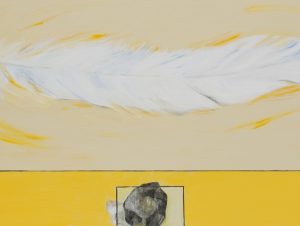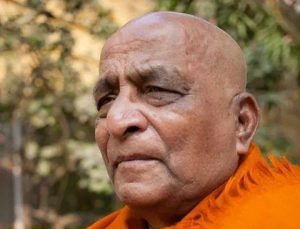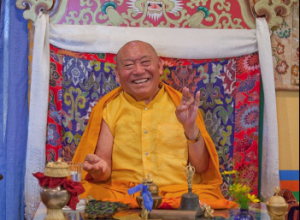
temple hall. Image courtesy of Sakuramotobou
Sakuramotobou is one of five “guardian” temples of Ominesan-ji, the temple and sanctuary on Sanjogadake Peak in the Omine mountain range. For more than a thousand years followers of Shugendo have made annual pilgrimages to this holy site.
The starting point for their ascent was Yoshino, where many more Shugendo temples existed from the seventh century. These temples offered lodgings for pilgrims before and after their pilgrimage.
Sakuramotobou was one of these temples until the late 19th century, when Shugendo was banned and numerous Shugendo temples were destroyed. Sakuramotobou was spared this fate, but the temple lost many historical records, ritual implements, and temple treasures during this time.
Fast forward to 2015, and a collection of priceless documents that bear testimony to Sakuramotobou’s history as an important Shugendo temple and lodging facility for pilgrims were found by chance.
Around the same time, a family tragedy happened at Sakuramotobou when the only male heir to the Tatsumi family, who have been running this temple for four generations, passed away from cancer.
The head priest’s daughter, Tatsumi Anju, now the only child, returned to the temple after 10 years of studying and living in Europe, in order to help her parents.
Anju (安寿) is her Buddhist name, which means “peace and felicitation.” Now she plays an important role at the temple and she has firmly established herself as a woman in the Shugendo temple world.
The author had an opportunity to talk deeply with Anju about the temple’s past, present, and future, about her role, and about the larger context of Shugendo in the 21st century.
This interview is published in two parts; this is part one of two. The author is very grateful for this interview and she would like to thank Tatsumi Anju for her frank and heartfelt answers.
BDG: What is your current role at Sakuramotobou?
Tatsumi Anju: I have been serving as Shinto priestess in terms of ceremony and ritual, and as for the operation of the temple, I have been the acting executive manager of Sakuramotobou since 2018.
First and foremost, I support gyoja* practices through helping my father, Ryonin, who is the head priest, carrying out a wide range of activities to assist them. This kind of help is done in the background and hence it is often not seen, but it is nonetheless crucial.
As a Shinto priestess, I am in charge of conducting all the Shinto rituals at our temple. These rituals include a ceremony in commemoration of Tenmu Tenno, the founder of Sakuramotobou, and the ceremonies at two other Shinto shrines on the premise of Sakuramotobou: the Benzaiten Shrine and the Takakura Inari Nyoujin Shrine. Traditionally these rituals have always been done in the Shinto style.
For many years, we asked a priestess from another shrine to help us conduct these rituals, but she recently retired. You know, we must carry on the rituals and ceremonies for all enshrined deities, no matter what. So I took over this role after I qualified as a licensed Shinto priestess.

Her father, Ryounin, sits opposite Anju. Her mother acts as the master of ceremonies. The temple’s gyoja team and
worshippers observe the ritual. Image courtesy of Sakuramotobou
BDG: What is your role at the temple as a woman?
TA: As a woman? I have never thought about my role in a gendered way. I just do what I can, what I need to do, and what I am requested to do. In this way I contribute within the range of my possibilities and help the people who come to us.
For example, I organize temple programs and activities for visitors who are not necessarily followers of Shugendo but mostly from the general public, such as meditation, sutra copying, retreats, and so on. And I am also the facilitator for these sessions. This means that I am issuing the instructions and I am responsible for the “after-care” of participants.
I have also become accustomed to being a lecturer. I hold seminars and lectures at our temple and at other places to teach people about Shugendo. I also do the paperwork to assist my father with his many lectures.
If you will, I am also the social media manager and regularly post on our temple’s Instagram and Facebook accounts to promote our temple and our various activities.
Last, but not least, I clean the temple and purify the halls. Purification and cleaning are a very important part of practice at any temple, in Shugendo too, and I absolutely enjoy it!
BDG: Could you become the head of Sakuramotobou in the future?
TA: This is difficult to answer simply because there has not been any such example yet at Ominesan guardian temples. To date, no woman has ever succeeded as the head priest of one of these temples.
The common idea, which the majority of people have about this, is that the temple daughter’s husband becomes a priest and takes over the temple. We don’t know about that as nothing is determined for me right now.
One thing that I am absolutely certain about is that I will be serving the deities at Sakuramotobou until I die, and I am proud of this fate. Whether as the head or not, I will definitely be involved in running the temple and carrying out rituals.
As a Shinto priestess and as woman, I want to open the gate of our temple not only for gyoja but for everyone who needs a place to heal their soul. I want create a place where visitors can feel that they are beautiful beings as they are. This is my vision.
BDG: What are some recent new activities at the temple in which you have been involved?
TA: We have started holding live-streamed goma fire ceremonies since 2020. This is an attempt to “go with the flow” in this time of change. What we do has not changed but how we do it, this has been changing.
In this way, we want to try to attract young people, a new generation of temple visitors, so to speak. We want to let them know that if they need somewhere to rest their soul or need someone to talk to other than their families, or if anyone out there needs some sort of help, we at the temple are here for them.
People are looking for healing, they look for some place where they can escape the cities and get fresh air in nature. They are also looking for a sort of hidden space where they can be more themselves without having to care about the various social pressures.

Her father Ryounin observes the ritual. Image courtesy of Sakuramotobou
BDG: Is this a way of modernizing Shugendo?
TA: It is not actually modernizing, but I think we are trying to go back to the origin. In the old days in Japan, temples used to also be schools, hospitals, counseling places, and community centers.
Shugendo is all about learning how to live our daily lives in harmony and in balance with others, how to live our life to the fullest, how to be kind and compassionate to each other. It teaches us how we humans should be and behave.
Especially under this disparity society, we are easily confused, lost, stressed out, and frustrated, and even mentally ill. We easily become selfish and forget kindness.
I want to deliver the messages of how important are the language we choose and the words we speak. They can light up someone’s heart or kill it. We should never forget that the starting point and the origin of everything is to learn how to stay humble.
I wish that Sakuramotobou can be like a school where this important essence of being human is taught to visitors, pilgrims, and gyoja alike, be they children or elderlies, girls or boys, women or men, through providing them with the opportunity of experiencing this temple and taking part in temple activities.
BDG: What trends do you see in the Shugendo population?
TA: The population of male gyoja is decreasing continuously. In fact, the “weekend gyoja” is common now. Most of the young gyoja have a regular job during the week and they do Shugendo activities only on weekends.
Financially, it is quite difficult for young people to become a gyoja now. In recent years, it has become harder to save money and spend money on something else rather than on the household budget and on children’s education.
Elderly gyoja, who are mostly retirees, are more flexible in terms of time and money, but at the same time it becomes physically harder for them to practice. Hence, they shift their style and duty to that of the “behind the scenes” gyoja.
Overall, it seems that people do not know how to access the Shugendo teachings or where to receive instruction. This is because most elderly gyoja groups do not have a website.
On a positive note, more and more women are curious about Shugendo because, generally speaking, women in Japan have become more interested in temple and shrine activities in recent years.
BDG: What do you think about the continuation of the ban of women on Ominesan-ji?
TA: When I was asked about the Ominesan restriction and the “nyonin kekkai” in another interview recently, I said: “It is not my project to open the mountain for women.” Maybe I sounded quite harsh? I will be happy if Ominesan will be open to everyone, of course.
However, it is complicated to achieve this. Even just talking about it is complicated since too many people are involved, physically and emotionally. Personally I wish that all stakeholders involved cooperate so that we can figure out the best way for everyone involved.
BDG: What can Shugendo teach us in the 21st century about our relationship with nature?
TA: Society in general and all sorts of systems are becoming digital and moving online, but there are things that should not shift to a digital and online format. Shugendo is definitely one of them!
Followers of Shugendo have always cared for nature because their training happens in nature and they venerate nature as their true teacher: placing themselves in the midst of nature and feeling what nature whispers to them with all of their senses.
We should never forgo using all of our senses directly. For as long as there is nature and people worship nature, Shugendo teachings are there to be experienced in a real forest-and-mountain setting.
With global warming and environmental changes becoming more and more serious day by day, Shugendo teachings could play an important role in the assessment of environmental issues and its practice could potentially help with finding possible solutions.

BDG: What can Shugendo actually offer to people now?
TA: Suggestions, we at Sakuramotobou would say. We continue to provide suggestions as we receive them from the deities as long as there are seekers and questions.
People knock at the door of Shugendo temples and they walk in through the gates seeking answers to how to live their lives happily and faithfully. They also seek to discover a way to contribute to their communities and to society at large.
There are no clear-cut answers that we can give those seekers because the deities do not instruct us loudly in words, nor do they direct us visually by gestures in a conventional way. They communicate with us in a subtle language and give us some ideas and tips, as sort of suggestions.
Then it is up to us humans to find out the meaning of these suggestions through experiencing with our body and feeling with our hearts. This is Shugendo, the “way of training and testing,” and it is what life is about, right?
BDG: Does Shugendo have a future then?
TA: Shugendo has been passed down from generation to generation for 1,300 years until today, so I am certain that there is a future! There is no holy book but the teachings have been carried forward by passing them on, word for word, hand to hand, from people to people. In this way, the teachings of En no Gyoja have never died, not even during the chaotic years of the Meiji Revolution.
However, it is up to people to take action. We cannot just wait until someone else does. It is such a bad habit of Japanese people now that, in many situations, nobody wants to take responsibility, so nothing is moving forward. We cannot afford to just sit back and wait for what this future is going to be. We ourselves have to recognize what the problems are and seek for solutions. There is always so much that we can do.
* Gyoja refers to a person (ja) who is undergoing ascetic training (gyo) in the sacred mountains of Japan.
See more
Related features from BDG
Women in Shugendo: Supporters, Leaders, or Both? Part 1
Women in Shugendo: Supporters, Leaders, or Both? Part 3













[…] Full article in English↓ https://www.buddhistdoor.net/features/women-in-shugendo-supporters-leaders-or-both-part-2/ […]